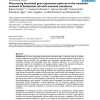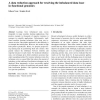269 search results - page 12 / 54 » A Minimax Method for Learning Functional Networks |
BMCBI
2006
13 years 7 months ago
2006
Background: Microarray technology produces gene expression data on a genomic scale for an endless variety of organisms and conditions. However, this vast amount of information nee...
NCA
2007
IEEE
13 years 7 months ago
2007
IEEE
Learning from imbalanced data occurs frequently in many machine learning applications. One positive example to thousands of negative instances is common in scientific applications...
BMCBI
2010
13 years 7 months ago
2010
Background: In the last decade, biochemical studies have revealed that epigenetic modifications including histone modifications, histone variants and DNA methylation form a comple...
NIPS
2008
13 years 9 months ago
2008
In this paper we aim to train deep neural networks for rapid visual recognition. The task is highly challenging, largely due to the lack of a meaningful regularizer on the functio...
ICANN
2009
Springer
14 years 2 months ago
2009
Springer
The best recent supervised sequence learning methods use gradient descent to train networks of miniature nets called memory cells. The most popular cell structure seems somewhat ar...


